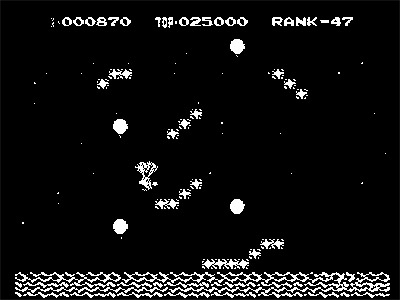 a review of Balloon Fight
a review of Balloon Fight
a videogame developed by nintendo R&D#1
and published by nintendo
for the arcades, the msx, the nec pc-8801, the nintendo entertainment system, the nintendo gameboy advance, the nintendo gameboy advance e-reader, the nintendo gamecube (as part of animal crossing), the nintendo wii virtual console, the sharp x1, the sharp zaurus and the watara supervision
text by Eric-Jon Rössel Waugh
Time was, Nintendo was a company was a game. Then Mario was a commodity was a template was a cult.
The guy who dragged Japan’s oldest hanafuda manufacturer into videogame design was a quiet, oddball toy inventor named Gunpei Yokoi. Thanks to Yokoi, Nintendo had already been making “inventive and strange” toys and arcade amusements; in the late ’70s, videogames were just the next logical step. He rounded up a posse, agreed to babysit a slacker friend of his boss’s family, and built from the ground up Nintendo’s first design studio: R&D#1.
Before long, the kid — an art school graduate named Miyamoto — set the editorial tone of bold colors, bolder concepts, and boldest character design. Then he graduated again to set up his own internal studio, and over the next five years completed and refined the two or three ideas he would ever have as a game designer. Meanwhile, Yokoi continued on as head of Nintendo’s primary studio, fostering the semi-anonymous design talents that led to craziness like Excitebike and Gumshoe, and external relationships with companies like Hal Labs (Pinball, Tennis). Whereas Miyamoto was an artist, with a few grand — if inward-looking — ideas of his own, Yokoi led a bunch of little professors, full of dainty ideas informed by everything new that walked down the street.
Where Miyamoto rehashed his own ideas time and again, building and honing his own style and vocabulary, Yokoi’s crew took everyone else’s ideas, studied them, stirred them up, and spit them out to see what happened. Sometimes the results were an improvement; sometimes they were just plain weird. Anyway, it would be fair to call Team Yokoi’s a more methodical approach to game development — compared to Miyamoto, who pretty much made things up as he needed them.
For a while, the balance was healthy. Throughout the ’80s, Yokoi’s studio defined Nintendo, being both responsible for its hardware and the bulk of its software design. Miyamoto was the golden child, to whom assigned the occasional mold-breaking blockbuster hit. After around 1989, Nintendo chose to narrow its focus, sidelining both Yokoi’s unit and its editorial voice — triggering a long decline only reversed when, about fifteen years later, Yokoi’s old pal Satoru Iwata, formerly of Hal Labs, was installed as president. Funny how that works.

Balloon Fight is R&D#1 in a nutshell: it’s just the 1982 Williams game Joust, broken down and reassembled as a more substantial, more whimsical product.The player, enemies, and setting are more charming. The controls are more forgiving, yet somehow more precise. The rules are changed for the less punitive — in that the player takes two hits to die — yet there are more and more interesting ways to die. Level design is more varied, and presents more things to do. Just as Treasure does, R&D#1 took Joust‘s shell, hollowed it out, and put the pieces back in, in a more logical and amusing order.
The next thing they did was a little weirder. Once they’d completed the main “Joust” mode, they took all of the game’s parts back out of the box and reassembled them into a different shape. Almost an afterthought, after the 1P and 2P “arcade” modes, is a third menu option labeled “Balloon Trip”. Where the main game is well-beefed arena violence, “Balloon Trip” is a thin, spit-and-twine one-player quest with a bitchin’ Hip Tanaka soundtrack. As the screen auto-scrolls, the player flies to the left, avoiding hazards and collecting bonuses. One death, and the trip’s off: back to the menu screen. It sounds frustrating, and it is — and that’s just what makes it great. It’s a hybrid survival mode and quest mode. You’ll play it again and again, just to see how far you can get this time.
A decade before every home port had a survival or tournament mode to “add value” over the arcade original, before everyone bitched that Half-Life 2 didn’t have a multiplayer mode out of the box, before unlockables, before Tekken Force and all the junk thrown into Smash Bros. to make it feel expensive enough, R&D#1 threw in an “added-value” one-player remix mode just for the hell of it.
Two decades on, “Balloon Trip” has become the game’s legacy. The game’s only real sequel, the (ostensibly) Game Boy-exclusive Balloon Kid, expanded “Balloon Trip” into a full platform-action game. Every further reference to Balloon Fight, whether in Smash Bros. on the GameCube or Wario Ware. on the Wii, has been either a rehash of or musical tribute to “Trip”. What we remember is a remix of a remix — yet without the original remix, the pieces would never have existed for the second draft.
More than any other game, Balloon Fight gives a window into R&D#1’s design process: analyze, break down, reassemble. From here you get Super Mario Land, Metroid, Game Boy Tetris, and — more recently — Wario Ware. It doesn’t take itself seriously, it has fun with its pieces, and it conveys that playfulness to the audience. It’s the product of a warm and ambitious spirit, strangled and left for dead nearly twenty years ago. And coming as it does from Nintendo’s first postmodern era, it feels weirdly current today. Granted, even with “Balloon Trip” the premise is kind of modest. Hell, though. Modesty is good. If videogames can learn to be modest again, maybe they’ll have a future after all.
–Eric-Jon Rössel Waugh
8 Responses to Balloon Fight